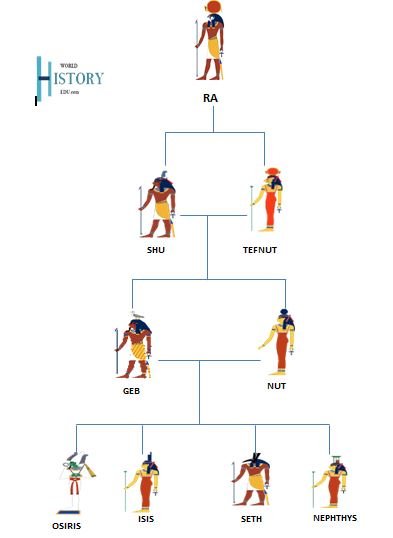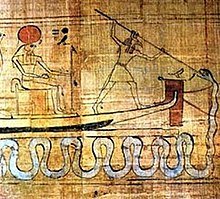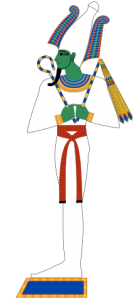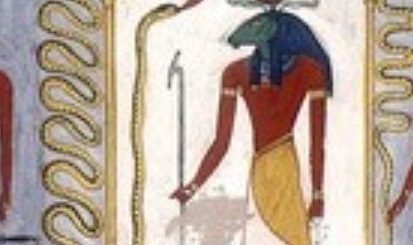Myths and Facts About Seth- the Egyptian God of Chaos and War

Seth Myths and Facts
According to several myths from ancient Egypt, Seth (sometimes known as “Set” or “Seteh” or “Satet”) was the god of chaos, anger, deceit, destruction, and war.
Largely feared as the god of infertile lands and the deserts, the ancient Egyptians believed Seth was the bringer of famine, storms, diseases and pestilence. At one point in the myth, Seth is believed to have killed his older brother Osiris and proceeded to hack the body into 14 pieces, before throwing the dismembered parts into the Nile River. Owing to this, Seth often had numerous battles with his arch rival and nephew, Horus – the falcon god and son of Osiris and Isis.
The following are some major myths and facts about Seth – the Egyptian god of chaos, storms and war:
Myth and Origin Story of Seth
Seth was born to parents Geb (Earth deity) and Nut (sky deity). Geb and Nut were part of the first few gods to emerge out of the primordial waters during creation.
After Atum (Ra) created the world, the deities Geb and Nut gave birth to the first five gods – Osiris, Isis, Nephthys, Horus the Elder, and Seth.
Ever since Seth god was born, he was fated to play the role of an adversary to order (ma’at). As a result, he came to be known as the “destroyer” or the “instigator of confusion”.
In ancient Egyptian pantheon, Seth was mainly seen as the patron god of chaos, destruction, foreigners, and foreign lands in desert and barren regions. Such was Seth’s thirst for violence and deception that anything with the color red somehow symbolized the god.

Family tree of Egyptian god Seth, the Egyptian god associated with evil, anger, storms and chaos.
Depictions and Epithets for Seth in Egyptian Mythology
The commonest physical depiction of Seth is when he is seen with an animal head – the “Set animal”. That animal to this day remains unknown. However, it appears to be an amalgamation of the heads of a donkey and a giraffe, as it has four legs, pointy ears, and a long snout.
Additionally, many ancient Egyptian sculptures and paintings show Seth with a long, forked tail and canine body.
As it was common with other Egyptian gods, Seth is depicted holding the ankh – the Egyptian symbol of power and authority. In his other hand, the god of destruction and war can be seen holding a staff.
Typically, Seth was associated with animals such as antelope, boar, crocodile, and the ass (donkey). It was also not out of place for the ancient Egyptians to associate Seth with creatures that they considered vile and dangerous. Some of those animals include: scorpions, snakes (serpent) and hippopotamus.
The Egyptians had several epithets for the god of chaos. The commonest ones were “the Lord of the Red Land”, “Lord of the Desert”, “Ruler of the South”, “Lord of Disharmony”, “Lord of Upper of Egypt”, and “God of foreigners”.
Ancient Egyptian cities that worshiped Seth
The worship of Seth in ancient Egypt varied from place to place, and from era to era. For example, ancient Egyptians during the Early Dynastic Period (31 to 26 BCE) very much loved and worshiped Seth as a benevolent god of love potions and spells. He was worshiped in a very good light, a heroic character, particularly in Upper Egypt (the south). Seth even served as the protector of the sun God Ra (Atum/Amun) from the serpent-demon Apophis.
In the New Kingdom Era, however, many of Seth’s good traits and deeds were cast aside, leaving his bad deeds gravely accentuated. The genesis of this can be traced to the Hyksos’ reign over areas around the eastern Nile Delta and Middle to Lower Egypt regions. Hyksos rulers were considered foreign invaders who chose Seth as their patron god. Some historians have stated that the Hyksos instituted a monotheistic ideology at one point in time. For example, King Apophis is believed to have worshiped no other god but Seth. Shortly after the Hyksos rulers were expelled by Pharaoh Ahmose I, Seth’s reputation as the evil god of the invaders/foreigners got cemented even further.
However, during the 19th Dynastic Period (also known as the Ramesside Period), the worship of Seth made a spectacular comeback. For example, the most famous temples of Seth were the Temple of Ombos in Nubt and Sepermeru (also known as the House of Seth). Additionally, 19th Dynastic Era pharaohs like Ramesses I, Seti I (also known as “Man of Set”), Setnakht (“Set is strong”) and Ramesses II all bore names and epithets in honor of Seth. Under these pharaohs, Seth was elevated to the status of patron god of Egypt. Notably speaking, Ramesses I (the founder of the 19th Dynasty) did this because of his association with the military men stationed at Avaris – a former Hyksos’ capital famous for the worship of Seth.
Read More: 12 Greatest Cities in Ancient Egypt
Seth’s Power and Abilities
Due to his ability to rain down unimaginable misery and chaos in the lives of Egyptians, Seth was given one of the highest veneration in the Egyptian pantheon.
As a matter of fact, some Egyptian pharaohs believed their might, power and authority came from the God Seth. Hence, they prayed to Seth to protect them from Seth himself. In times of famine or any other natural calamity, they believed Seth was in the process of making inroads into the fertile lands of Egypt.
It is also likely that some pharaohs purposely invoked his name to inspire fear among their subjects. Being the god of war and destruction, Seth was believed to be a very skilled and intelligent fighter, often coming into direct confrontation and battles with Horus, the falcon headed god.
Egyptians believed Seth granted protection to soldiers, merchants and soldiers. Regarding the latter, Seth was believed to sow discord and confusion in the camp of Egypt’s enemies.
Ra’s Companion and Protector

Seth protecting Ra from the evil serpent Apophis. Set was the only Egyptian deity who could resist Apophis’ deadly stare.
On a daily basis, the Creator God Ra rode in his sun barge across the sky bringing daylight to the people of ancient Egypt. According to the myth, Ra made those daily trips often in the company of fellow deities like Thoth, Ma’at and Seth. And every night, Ra would come face to face with the hideous demon called Apophis – the agent of chaos.
Due to the immense magical power Apophis (also known as Apep or Apopis) possessed, the creature was able to cast a hypnotic spell on all the deities aboard Ra’s sun boat, except Seth.
Ancient Egyptians believed Seth was the only god that could go toe to toe with Apophis. Every night, Seth would slay the demon Apophis, least the entire land of Egypt be engulfed in a perpetual darkness. Owing to Seth’s effort, the people of ancient Egypt could peacefully wake up to the rise of the sun.
How Did Seth kill Osiris?
According to the myth of Osiris, the ancient Egyptians believed Osiris, being the first of the five gods, was crowned ruler of the land of Egypt.
Osiris – the god of the living and fertility – was a just and fair ruler of Egypt, giving the people agriculture, rules and laws, and culture. Many ancient Egyptians lived in complete harmony, balance and peace under Osiris’ rule. It was a time of massive prosperity as the Nile flooded its banks and placed rich black soil across the land of Egypt.
Seeing all the good works that Osiris did for the people of Egypt, Seth became infuriated and jealous of Osiris’ rule. He desired to usurp Osiris from the throne. The situation even got worse after Seth’s wife, Nephthys, had an affair with Osiris. The myth goes on to say that the product of that unfaithful union between Osiris and Nephthys was Anubis, the god of funeral and embalming.
Filled with rage and jealousy, Seth schemed to kill his brother. He organized a grand party and invited Osiris and other influential Egyptian gods and goddesses. During the party, Seth initiated a game where he asked every god and deity present to enter the casket in order to determine who would fit in it perfectly.

Unknown to Osiris, Seth purposely built the casket to fit him. Once the casket was sealed shut, Seth threw the casket into the Nile, leaving Osiris to suffocate and die. Image: Osiris – Egyptian god of the Underworld
All the gods and goddesses took turns trying the casket out. When it got to Osiris’ turn, the casket fit the god brilliantly. Seth then immediately sealed the casket and threw it into the Nile. Osiris was left to suffocate and die in the coffin as it floated down the Nile.
In other accounts, the story goes on to say that Seth cut Osiris’ dead body into 14 pieces and later scattered those pieces across the earth.
The goddess Isis, Osiris’ wife, would then seek help from Anubis to bring Osiris back to life. However, Osiris did not come back to life in the land of the living; instead, Osiris went on to be reborn in the afterlife as the “Lord of the Underworld/Dead”.
With Osiris dead, Seth took the throne of Egypt. His reign, which spanned about 80 years, was very chaotic and disastrous. The entire land of Egypt was plunged into years and years of drought, hunger and diseases.
Unbeknownst to Seth, prior to Osiris descent into the underworld, Osiris fathered a son with Isis. The son’s name was Horus – the falcon god of the sky. Horus would grow up with one goal in mind – defeat Seth and take back the throne of Egypt.
The Demonization of Seth — Conflict between Seth and Horus
The primary reason why Seth was often depicted as the “devil” or an evil being in Egyptian mythology is because the Egyptians believed Seth was the usurper, the god that murdered his own brother in order to cease control of the land of the living.
Aiming to take back his father’s throne, Horus engaged Seth in several epic battles. With the majority of Egyptian gods and deities on the side of Horus, including his mother Isis, Horus defeated Seth on a number of occasions. Wounded and distraught, Seth was banished out of the land of Egypt into the red deserts and barren wastelands that bordered Egypt.
The story goes on to say that the panel of judges deemed Horus fit and crowned Horus the rightful king of Egypt. Horus’ reign ushered in the line of pharaohs’ succession. He was recognized as the first king of ancient Egypt, and his reign is believed to have restored the principles of Ma’at, i.e. balance, equality and prosperity. During Horus’ reign, his mother, Isis, served as queen consort in the land of Egypt.
Seth’s association with the ancient Greek monster, Typhon
Essentially speaking, Seth’s role in the pantheon grew into one who opposed Ma’at’s principles of truth, law and order. The ancient Greeks (particularly Plutarch) saw Seth in similar light as the terrible Greek monster Typhon. They believed the creature Typhon was the issue of Gaia, the goddess of earth. And like Seth, Typhon challenged the kingly authority of Zeus. In the end Zeus cast him out to Tartarus – a hell-like place deep into the bowels of the underworld.
Thus, both Typhon and the Seth of the New Kingdom era played similar roles in their respective pantheons. They were both portrayed as controversially evil deities whose sole purpose was to wreak havoc and destruction. Some versions of the story further vilified Seth by equating him to the serpent-demon Apophis.
Seth sends venomous snakes to kill Horus
Egyptian god of chaos and storms was associated with crocodiles and poisonous snakes. In one account of the myth, Seth sends a poisonous snake into the cradle of Horus the infant, who at the time had been hidden in the marshes of the Nile Delta in order to protect him from Seth. Isis, who had gone out to fetch some food, returned to find the baby Horus severely wounded. She quickly reached out to Thoth, the Egyptian god of knowledge, to resuscitate Horus. The baby Horus lived and thus was praised as the infant who survived a venomous snake bite.
Read More:
10 Interesting Facts about Egyptian God Seth

Seth Myths and Facts. Seth’s role was to function as an opposing force to Ma’at or divine order. | Seth (left) and Osiris (Right) blessing Pharaoh Ramesses
Here are ten very interesting facts about Seth- the ancient Egyptian patron god of chaos:
- The temporary reign of foreign invaders in Egypt resulted in the eviction of Seth from the Egyptian pantheon. As time passed, Seth increasingly became associated with foreign deities of the Hittites, Assyrians and the Persians. For example, the Assyrian goddess Anat was commonly regarded as Seth’s consort. So was Astarte, the Phoenician goddess queen of heaven.
- In sharp contrast to his nephew Horus, the falcon headed god of the black (fertile) lands in Lower Egypt, Seth was seen as the supreme lord of the red land and barren desert regions outside of Egypt.
- Although he was typically associated with evil deeds, Seth’s role was very important when it came to defeating the serpent Apophis. As a result Seth’s magnanimous role, the people of ancient Egypt could wake up and see the bright morning sun.
- After Seth killed Osiris, it is believed Isis (Osiris’ wife) collaborated with Anubis (the god of the funeral and embalming) to resurrect Osiris. Isis painstakingly picked the body parts (14 of them) of Osiris that had been scattered across the face of the earth. It is believed the 14th body part of Osiris (most likely his penis) was feasted on by the oxyrhynchus fish. With the help of Anubis, the mummification process was carried on the body of Osiris, making Osiris the first mummified corpse in ancient Egypt.
- During Seth’s numerous battles with Horus, Ra, the creator god, supported Seth. Ra believed that Horus was too young and inexperienced to rule over Egypt. However, Ra would later change his minds due to immense sufferings and hardships that Seth brought to the people of Egypt.
- Another account of the myth states that the battle between Seth and Horus for the throne went into stalemate. The gods then sought the help of the goddess wisdom, war and creation Neith to adjudicate on the issue. Neith ruled in favor of Horus. Horus was crowned the lord of the land of the living, first king of Egypt. However, Seth was given dominion over the red deserts outside Egypt. Set also received the Goddess Anat and Astarte as consorts.
- The only king in the Early Dynastic Period to venerate Seth as the patron god of Egypt was Peribsen – sixth king in the Second Dynasty.
- 19th Dynastic pharaohs of ancient Egypt prayed to both Seth and Osiris to officiate the coronation ceremony.
- Many historians can’t help but notice the striking similarities between Osiris myth and early Christianity mythology. Many people believe that the devil (Satan) is portrayed in the same way the ancient Egyptians portrayed Seth. In the New Testament, Jesus Christ’s temptation in the desert by the devil seems very similar to what Seth – the Egyptian god of the deceit and the desert – could do.
- Considering how no society is ever devoid of chaos and natural tragedies, Seth’s cult in ancient Egypt was one of the first cults to spring up.



























